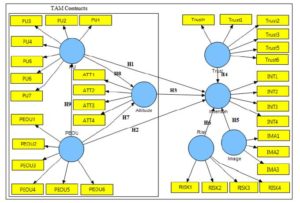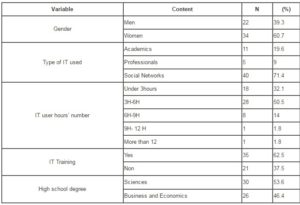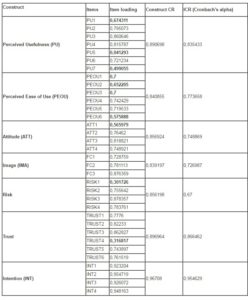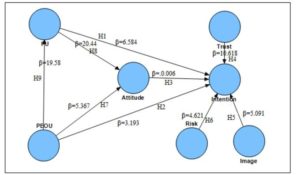Introduction
Investment in Information Technology (IT) enabled changing in business environment. It presents a strategic hub of economic development where micro and small e-businesses have emerged as important players (Matlay and Martin, 2009). Moreover, it generates new form of entrepreneurial activities called e-entrepreneurship (Matlay, 2004; Kollmann, 2006). The later points up the act of creating new companies based on IT (Matlay, 2004).
Morocco, as a developing country, is aware of the rapid IT progress. It is engaged on a national strategy called “Moroccan Innovation Initiative”. This strategy is based on the development of IT clusters. It aims to enhance e-entrepreneurship by supporting and creating a favorable technology environment throughout development of innovative projects in IT fields. Hence, it intends creating 100 innovative start-ups per year beginning2014. For this target, several actions were made:
• Create the Moroccan Innovation Center to support e-entrepreneurs.
• Launch the Moroccan Numeric Fund to promote and stimulate e-entrepreneurship.
• Establish an IT cluster to develop IT projects generating added value.
Success of the Moroccan Innovation Initiative is conditioned by the rise of project based IT, otherwise by e-entrepreneurship success. However, this later is conditioned by the acceptance of e-entrepreneurship by future entrepreneurs.
Thispaper aims to identify factors influencing e-entrepreneurship acceptance by future entrepreneurs in Morocco. It attempts to answer question: what are the factors influencing e-entrepreneurship by these entrepreneurs?It is based on main constructs of Technology Acceptance Model(TAM) and added three constructs, “Trust”, “Image” and “Risk” to understand this acceptance. The study concerned studentsat the national school of business and management and considered as the future entrepreneurs.The second section will define the e-entrepreneurship concept and present the theoretical background of the TAM Model. The third one will describe the suggested research model and cite the nine hypotheses. The fourth section will explain the research methodology. The fifth will examine data and reveal the findings. These later will be discussed in the sixth paragraph, and then followed by conclusion, managerial implications and limits of this research work in the last section.
Theoretical Background
The following paragraph highlights e-entrepreneurship concept and presents the Technology Acceptance model
According to the European commission, entrepreneurship can be defined as a certain mindset and process associated with individuals, showing a set of competencies (e.g. creativity, risk-taking…) by turning a business idea into success. As for the IT context, several authors advanced e-entrepreneurship concept. Matlay (2004) noted that e-entrepreneurship refers to the act of establishing new companies specifically in the Net Economy. As for Kollmann (2006), he stated that that e-entrepreneurship consist on setting a new company with an innovative business idea within this Net Economy. Otherwise, e-entrepreneurship is used to mean the process of establishing a new company with an innovative business in the Information Technology sector. In this paper, we consider that an e-entrepreneurship is an entrepreneur who invests in project based IT.
Technology Acceptance Model (TAM)
In 1989, Davis et al based on the reasoned action theory (Fishbein and Ajzen, 1975) to develop a theoretical model called Technology Acceptance Modelto predict computer usage. Since it was developed, it is proved to be the most powerful model to point out variables predicting and explaining IT acceptance (Adams and al, 1992; Igbaria, 1993; Chang, 1998).
TAM postulates that IT actual use can be determined by behavioral intention. The latter is influenced by Attitude. According to Ajzen (1991), attitude is a predisposition to answer an object in a favorable or unfavorable way. As for Triandis (1980) Attitude indicates the affect. It is defined as the feeling of pleasure, gaiety and dissatisfaction that associates individual to a given behavior. It expresses the positive or negative feelings about performing the IT acceptance (Davis, 1989).
Within this model, Davis (1989) defines the two constructs that are of primary relevance to computer acceptance behaviors:
– Perceived usefulness (PU): It is one of the prior belief constructs developed by TAM. It is defined as the degree to which a person believes that using a particular system would enhance his or her job performance (Davis et al 1989). It represents a theoretical substitute of the relative advantage developed in the Innovation Diffusion Theory (Roger, 1995). PU is proved to be relevant determinant of IT acceptance.
– Perceived ease of use (PEOU) refers to the degree to which a person believes that using a particular system would be free of effort (Davis et al., 1989). It indicates degree to which user finds that the use of a technology is relatively deprived of effort. Technologies perceived as being easier to use and less complicated are more likely to be accepted by potential users. Compared to perceived usefulness, perceived ease of use is considered the second important determinant of a user’s IT acceptance.
TAM is considered one of the most widely applied models to predict IT acceptance. Thereby, this work referred to it to develop a model that helps to predict acceptance of e-entrepreneurship by future entrepreneurs in developing countries, the purpose of the following paragraph
Research Model and Hypotheses
The research model is inspired from TAM (Davis et al, 1989). It includes three principal TAM constructs: Perceived Usefulness, Perceived Ease of Use, and Attitude. Three added constructs “Trust” and “Image” and “Risk” extended this model in order to predict the Moroccan future entrepreneurs’ intention to accept IT (Fig. 1).
Trust construct is considered due to its importance to predict individual intention to accept IT within organizations (Tang et al, 2008).Regarding Image; it is drawn from (Venkatesh and Davis, 2000). It is due to the need of the future entrepreneurs in developing countries to improve their image within their society. They thought that investment in project IT could improve their image towards other entrepreneurs. As for Risk, it is integrated to explain risk taking of future entrepreneurs in developing countries towards project base IT.
Based on the relationships proposed by the TAM model, we consider the following hypotheses:
H1: Perceived Usefulness is positively related to the Moroccan future entrepreneurs’ intentions to accept e-entrepreneurship.
H2: Perceived Ease Of Use is positively related to the Moroccan future entrepreneurs’ intentions to accept e-entrepreneurship.
H3: Attitude toward IT is positively related to the Moroccan future entrepreneurs’ intentions to accept e-entrepreneurship.
H7: Perceived Ease Of Use is positively related to the Moroccan future entrepreneurs’ attitude toward e-entrepreneurship acceptance.
H8: Perceived Usefulness is positively related to the Moroccan future entrepreneurs’ attitude toward e-entrepreneurship acceptance.
H9: Perceived Ease Of Use is positively related to Perceived Usefulness.
Besides to these six hypotheses adapted from TAM, based on the three added constructs, Trust, Image and risk, we considered three more hypotheses.
Image is defined as the degree to which use of an innovation is perceived to enhance one’s [. . .] status in one’s social system (Moore and Benbasat, 1991). In the Moroccan context, an entrepreneur who had a higher need for social recognition is likely to invest in project based IT. Hence we hypothesized:
H5: Image is positively related to the Moroccan future entrepreneurs’ intentions to accept e-entrepreneurship.
Trust is defined as the measure of the belief and goodwill that policymakers feel in and for, trusted people (Doney et al 1998). Garbarino and Johnson (1999) added that Trust is the customers’ confidence in quality and reliability of the services offered by an organization. Prior studies pointed out the positive direct relation between Trust and Intention (Gefen et al 2003). For this paper we hypothesize that Trust influences directly the Moroccan future entrepreneurs’ intentions to accept e-entrepreneurship. Hence we retained the following hypothesis:
H4: Trust is positively related to the Moroccan future entrepreneurs’ intentions to accept e-entrepreneurship.
As for the risk, referring to Mitchell 1992, it explains uncertainty in a given situation. Featherman and Pavlou (2003) added that it is related to the possibility of experiencing negative consequences or losses in uncertain situations. The two authors underlined that Risk could comprise several facets: performance, financial, time, psychological, social, privacy and (7) overall risk. In this work, Risk implies negative perception of the future entrepreneurs toward uncertainty results of investment in project based IT. Thus, these entrepreneurs consider this investment more riskily and tend to be reluctant toward e-entrepreneurship.So, we hypothesized:
H6: Risk is negatively related to the Moroccan future entrepreneurs’ intentions to accept e-entrepreneurship. 
Figure 1 Research Model
Research Methodology
Students of the fourth year accounting and financial management at the national school of business and management located in Agadir city represent the target population. They correspond to a total of 90 individuals. Data were collected by a questionnaire developed and administrated online. The data collection process took place four days, from the 20May 2013 till 23 May 2013. Of the 90 students, only 56 individuals participated at the study representing 62% of the response rate. Most of the respondents were female (60.7%) and with a scientific degree (53.4%). Majority of these respondents (71.4%) used social networks technologies for more than 3 hours per a day (68.1%) and got IT training (62.5%) (Table 1).
Scales used for this study were adapted from the works of Davis et al (1989), Venkatesh and Davis (2000), Tung et al. (2008) and Featherman and Pavlou (2003). The measurement items were anchored on a 7-point Likert scale from “strongly disagree” (1) to “strongly agree” (7) in which respondents indicated an appropriate response.
Table1. Demographic profile of the sample (N=56)

Data Analysis and Results
To test the research model, we used the Partial Least Squares (PLS) technique, which is appropriate to validate predictive models using reflective latent constructs(Chin, 1998). This technique also places minimal demands on sample sizes and data distribution assumptions. We used Smart PLS software version 2.0M3 to assess both of the measurement model and the structural model.
Measurement Model
The reliability of construct measurement was assessed by the composite reliability and internal consistency. The internal consistence was assessed the Cronbach’s Alpha coefficient. It is verified when the alpha is above 0.7. Regarding table 2, all constructs indicated composite reliability above 0.7. Moreover, internal consistency of the scales is verified, for Perceived Usefulness, Perceived Ease of Use, Attitude, Image, Trust and Intention because their Cronbach’s Alpha exceeded threshold value and confirmed a satisfactory reliability. It is also considered for “Risk” construct, as its Cronbach’s Alpha value is near to 0.7 (0.67).
Table 2: Items loading, Construct composite reliability (CR), internal consistency reliability (ICR)
Convergent validity assessed the degree to which different instruments are able to measure the same construct (Portney and Watkins, 2000). It is measured by the factor loadings of the items on the model’s constructs. Barclay, Higgins, and Thompson (1995) recommended that an observed principle for convergent validity is to retain items with loadings of 0.70 or more. Table 2 showed that all items, exceptPU1 (0.67431), PU5 (0.04129), PU7 (0.499055), PEOU2 (0.652205), PEOU6 (0.575888), ATT1 (0.565979), RISK1 (0.301726), TRUST4 (0.316817) indicated a loading value above 0.7. Hence these items with value under 0.7 were removed from the analysis.
Discriminate validity is assured when the AVE value is above the threshold value of 0.50 and square root of the AVE is larger than all other cross correlations (Gefen and Straub, 2005). Table 3 showed the diagonal values (bold) are greater with respect to the corresponding correlation values in the adjoining columns and rows, hence the discriminate validity was confirmed.
Table 3 AVE, Diagonal elements are the square root of the shared variance between the constructs and their measures (AVE); off-diagonal elements are correlations between constructs (N= 56).
Structural Model
The structural model provides information about the model’s predictive power given by R2 and information about path significance. We run PLS-Graph using a nonparametric test of significance known as bootstrapping method with 100 resamples to determine the significance levels for loadings weights and path coefficients (Gil-Garcia, 2008)
Results showed that the research model explained 40% of total variance in the intention to in the intention of the future entrepreneurs to accept e-entrepreneurship (Fig. 2). They revealed that Perceived Usefulness (β =6.584), Perceived Ease Of Use (β =3.193), Trust (β=10,618), Image (β= 5.091) and Risk(β= 4.621)had significant influence on this intention, while the influence of Attitude was insignificant.
Figure 2: Structural model
Discussion
hypothesis1 (H1), supposing that Perceived Usefulness will have a positive influence on Moroccan future entrepreneurs intention to accept e-entrepreneurship (H1) was supported. It means that future entrepreneurs in developing countries give more importance to the utilitarian aspect of project based IT. This may suggest that these entrepreneurs are relatively pragmatic andtend to investin IT project with highly profitability.
Hypothesis 2 (H2), suggesting that Perceived Ease Of Use will have a positive influence on Moroccan future entrepreneurs intention to accept e-entrepreneurship, was supported. Hence, in developing countries future entrepreneurs will be ready to invest in project based IT if these technologies are understandable and easy to use.
Hypothesis 3 (H3), predicting that Attitude will have a positive influence on Moroccan future entrepreneurs’ intention to accept e-entrepreneurship, was rejected. This result emphasizes absence of negative or positive feelings of future entrepreneurs in developing countries toward benefits from investment on project based IT.
Hypothesis 4 (H4), supposing that Trust will have a positive influence on Moroccan future entrepreneurs’ Intention to accept e-entrepreneurship, was supported. This result indicates that while the future entrepreneurs trust in IT, it will foster their acceptance to invest in project based IT.
As for the link between Image and Moroccan future entrepreneurs’ Intention to accept e-entrepreneurship, results revealed that Image had a significant impact on this intention, then supporting hypothesis H5. It means that in developing countries investment in project based IT would be an opportunity to demonstrate skills and knowhow of the future entrepreneurs. They believed that their image among other entrepreneurs would be improved.
Results revealed that Risk influence negatively the Moroccan future entrepreneurs’ Intention to accept e-entrepreneurship, then Hypothesis 6 was supported. This result explained that in developing countries, future entrepreneurs have a risk aversion toward investment on project based IT.
Conclusion, Managerial Implications and Limitations
This paper aims to identify factors influencing e-entrepreneurship by future entrepreneurs in developing countries. These entrepreneurs were represented by future laureates of the national school of business and management. Results suggest that the modified TAM model was able to provide an explanation of e-entrepreneurship acceptance by these laureates. Moreover, results showed that two core constructs of TAM model seem to be significant for this acceptance. The first one, Perceived Usefulness, implies that future entrepreneurs give more importance to the utilitarian aspect of the project based IT. The second, Perceived Ease Of use, posits that future entrepreneurs are ready to invest in project based IT whenever these technologies are understandable and easy to use. Furthermore, results point out the future entrepreneurs’ confidence in quality and reliability of the project based IT. Also, these entrepreneurs believe in the improvement of their image t whenever they invest in project based IT. Moreover, future entrepreneurs do not hide the substantial risk of such investment in these projects.
As managerial implication of the current study, it proposed a useful tool for government managers and policymakers in developing countries to outlines IT strategies and assess investments in project based IT. It helps them to understand factors fostering IT acceptance especially by future entrepreneurs.
The sample size of 56 represents a limitation to this research could bias results. Future work should attempt to integrate more constructs and include more accurate representation of the sample.
(adsbygoogle = window.adsbygoogle || []).push({});
References
1. Adams, D.A., Nelson R.R. and Todd, P.A. (1992) ‘Perceives Usefulness, Ease of Use, and Usage of Information Technology: A Replication’ MIS Quarterly, 16( 2), pp. 227-247
Publisher – Google Scholar
2. Ajzen (1971), Ajzen, I. (1991), ‘The theory of planned behavior’. Organisational Behavior and Human Decision Process, 52(2), pp. 179-211.
3. Barclay, D., Higgins, C., (1995) and Thompson, R., “The partial least squares (PLS) approach to causal modeling: personal computer adoption and use as an illustration,” Technology studies, 2(1), 285-309.
4. Chang, MI K., (1998) ‘Predicting Unethical Behavior: A Comparison of the Theory of Reasoned Action and the Theory of Planned Behavior’ Journal of Business Ethics, 17(1), pp. 18225-1834
5. Chin, W. W. (1998), ‘Commentary: Issues and opinion on structural equation modeling’. MIS quarterly, 22 (1) vii-xvi.
6. Gefen, D., Karahanna, E. and Straub.D.W., (2003),’Trust and TAM in online shopping: An integrated model’ MIS quarterly. pp. 51-90. 2003.
7. Davis, F. D., (1989) ‘Perceived usefulness, perceived ease of use, and user acceptance in information technology’, MIS Quarterly,13(3), pp. 319-340.
8. Davis,F.D., Bagozzi, R., and Warshaw, P. (1989), ‘User acceptance of computer technology: a comparison of two theoretical models’ Management science, 35 (1), pp. 982-1003,
Publisher – Google Scholar
9. Doney, P. M., Cannon, J. P. and Mullen, M. R. (1998), ‘Understanding the influence of national culture on the development of trust’, Academy of management review, 601-620.
Publisher – Google Scholar
10. Featherman, M.S., and Pavlou,P.A., (2003), ‘Predicting e-services adoption: a perceived risk facets perspective’, Int. J. Human-Computer Studies 59, pp.451–474
Publisher – Google Scholar
11. Gefen, D., and Straub, D.W., (2005), A Practical Guide to Factorial Validity Using PLS-Graph: Tutorial and Annotated Example. Communications of AIS, 16 (1), 91-109.
12. Igbaria, M., (1993) ‘User Acceptance of Microcomputer Technology: An Empirical Test’, Omega Int J. of Mg& Sci, 21(1) pp. 73-90.
Publisher – Google Scholar
13. Kollmann, T. (2006). What is e-entrepreneurship? Fundamentals of company founding in the net economy. International Journal of Technology Management, 33(4), 322-340.
Publisher – Google Scholar
14. M. Fishbein M. and Ajzen,I. (1975), ‘Belief, Attitude, Intention and Behaviour: An Introduction to Theory and Research’, Addison-Wesley, Reading, MA.
15. Matlay, H. (2004), E-entrepreneurship and small e-business development: towards a comparative research agenda, Journal of Small Business and Enterprise Development, 11 (1) , pp.408–414
Publisher – Google Scholar
16. MatlayH., and Martin, L. M. (2009), ‘Collaborative and competitive strategies in virtual teams of e-entrepreneurs: a pan-European perspective’, Australasian Journal of Information Systems. 16(1), 99-115.
17. Mitchell, V.-W., (1992), ‘Understanding consumers’ behavior: can perceived risk theory help? ‘Management Decision 30 (2), 26–31.
18. Portney LG, Watkins MP Correlation, (2000), Chapter 23 in: Portney LG, Watkins MP, editors. Foundations of clinical research — applica-tion to practice, 2nd ed. New Jersey: Prentice-Hall Health 2000; p. 491–508
19. Rogers, E. M.,(1995),Diffusion of Innovations”.4th ed. New York, NY: The FreePress
20. Triandis, H.C. (1980) ‘Values, Attitudes and Interpersonal Behavior’. Nebraska Symposium on Motivation 1979: Beliefs, Attitudes and Vaiues, University of Nebraska Press, Lincoln, pp.195-259
21. Tung, F. C., Chang, S. C. and Chou, C. M. (2008), ‘An extension of trust and TAM model with IDT in the adoption of the electronic logistics information system in HIS in the medical industry’. International Journal of Medical Informatics, 77(5), 324-335
Publisher – Google Scholar
22. Venkatesh,V., and Davis, F.D. (2000), ‘A theoretical extension of the technology acceptance model: four longitudinal field studies’, Manage. Sci. 46 (1),pp186–204.
Publisher – Google Scholar







